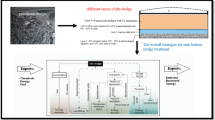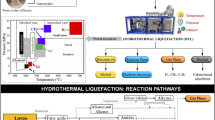Abstract
Oily wastewater generated by various industries creates a major ecological problem throughout the world. The traditional methods for the oily wastewater treatment are inefficient and costly. Surfactants can promote the biodegradation of petroleum hydrocarbons by dispersing oil into aqueous environment. In the present study, we applied rhamnolipid-containing cell-free culture broth to enhance the biodegradation of crude oil and lubricating oil in a conventional aerobically-activated sludge system. At 20 °C, rhamnolipids (11.2 mg/L) increased the removal efficiency of crude oil from 17.7% (in the absence of rhamnolipids) to 63%. At 25 °C, the removal efficiency of crude oil was over 80% with the presence of rhamnolipids compared with 22.3% in the absence of rhamnolipids. Similarly, rhamnolipid treatment (22.5 mg/L) for 24 h at 20 °C significantly increased the removal rate of lubricating oil to 92% compared with 24% in the absence of rhamnolipids. The enhanced removal of hydrocarbons was mainly attributed to the improved solubility and the reduced interfacial tension by rhamnolipids. We conclude that a direct application of the crude rhamnolipid solution from cell culture is effective and economic in removing oily contaminants from wastewater.
Similar content being viewed by others
References
Abalos, A., Viñas, M., Sabaté, J., Manresa, M.A., Solanas, A.M., 2004. Enhanced biodegradation of Casablanca crude oil by a microbial consortium in presence of a rhamnolipid produced by Pseudomonas aeruginosa AT10. Biodegradation, 15(4):249–260. [doi:10.1023/B:BIOD.0000042915.28757.fb]
Abouseoud, M., Maachi, R., Amrane, A., Boudergua, S., Nabi, A., 2008. Evaluation of different carbon and nitrogen sources in production of biosurfactant by Pseudomonas fluorescens. Desalination, 223(1–3):143–151. [doi:10.1016/j.desal.2007.01.198]
Allard, A.S., Neilson, A.H., 1997. Bioremediation of organic waste sites: a critical review of microbiological aspects. Int. Biodeter. Biodegrad., 39(4):253–285. [doi:10.1016/S0964-8305(97)00021-8]
Al-Shamrani, A.A., James, A., Xiao, H., 2002a. Destabilisation of oil-water emulsions and separation by dissolved air flotation. Water Res., 36(6):1503–1512. [doi:10.1016/S0043-1354(01)00347-5]
Al-Shamrani, A.A., James, A., Xiao, H., 2002b. Separation of oil from water by dissolved air flotation. Colloid. Surf. A, 209(1):15–26. [doi:10.1016/S0927-7757(02)00208-X]
ASTM D971-99a, 2004. Standard Test Method for Interfacial Tension of Oil Against Water by the Ring Method. ASTM international, West Conshohocken, Pennsylvania. Available from http://www.astm.org/Standards/D971.htm [doi:10.1520/D0971-99AR04]
Bai, G., Brusseau, M., Miller, R., 1997. Biosurfactant-enhanced removal of residual hydrocarbon from soil. J. Contam. Hydrol., 25(1–2):157–170. [doi:10.1016/S0169-7722(96)00034-4]
Carvalho, G., Novais, J.M., Pinheiro, H.M., Vanrolleghem, P.A., 2004. Model development and application for surfactant biodegradation in an acclimatising activated sludge system. Chemosphere, 54(10):1495–1502. [doi:10.1016/j.chemosphere.2003.08.028]
Chang, I., Chung, C., Han, S., 2001. Treatment of oily wastewater by ultrafiltration and ozone. Desalination, 133(3):225–232. [doi:10.1016/S0011-9164(01)00103-5]
Clifford, J., Ioannidis, M., Legge, R., 2007. Enhanced aqueous solubilization of tetrachloroethylene by a rhamnolipid biosurfactant. J. Colloid Interf. Sci., 305(2):361–365. [doi:10.1016/j.jcis.2006.10.026]
Costa, S.G.V.A.O., Nitschke, M., Haddad, R., Eberlin, M.N., Contiero, J., 2006. Production of Pseudomonas aeruginosa LBI rhamnolipids following growth on Brazilian native oils. Process Biochem., 41(2):483–488. [doi:10.1016/j.procbio.2005.07.002]
Lee, M.J., Lee, M.J., Kim, M.K., Kim, M.K., Kwon, M.J., Deog, P.B., Kim, M.H., Michael, G., Lee, S.T., 2005. Effect of the synthesized mycolic acid on the biodegradation of diesel oil by Gordonia nitida strain LE31. J. Biosci. Bioeng., 100(4):429–436. [doi:10.1263/jbb.100.429]
Miller, R.M., Bartha, R., 1989. Evidence for liposome encapsulation for transport-limited microbial metabolism ofsolid alkanes. Appl. Environ. Microbiol., 55(2):269–274.
Mitsui, T., Nakamura, S., Harusawa, F., Machida, Y., 1971. Changes in the interfacial tension with temperature and their effects on the particle size and stability of emulsions. Colloid Polym. Sci., 250(3):227–230.
Mohan, P.K., Nakhla, G., Yanful, E.K., 2006. Biokinetics of biodegradation of surfactants under aerobic, anoxic and anaerobic conditions. Water Res., 40(3):533–540. [doi:10.1016/j.watres.2005.11.030]
Noordman, W.H., Wachter, J.H.J., Boer, G.J., Janssen, D.B., 2002. The enhancement by surfactants of hexadecane degradation by Pseudomonas aeruginosa varies with substrate availability. J. Biotechnol., 94(2):195–212. [doi:10.1016/S0168-1656(01)00405-9]
Patel, R.H., Desal, A.J., 1997. Surface-active properties of rhamnolipids from Pseudomonas aeruginosa GS3. J. Basic Microbiol., 37(4):281–286. [doi:10.1002/jobm.3620370407]
Qing, J.L., Qing, O.Z., Ouyang, Z.Y., 2005. Ecological behavior of linear alkylbenzene sulfonate (LAS) in soilplant systems. Pedosphere, 15(2):216–224.
Rosso, D., Larson, L., Stenstrom, M., 2006. Surfactant effects on alpha factors in full-scale wastewater aeration systems. Water Sci. Technol., 54(10):143–153. [doi:10.2166/wst.2006.768]
Soda, S., Ike, M., Fujita, M., 1998. Effects of inoculation of a genetically engineered bacterium on performance and indigenous bacteria of a sequencing batch activated sludge process treating phenol. J. Ferment. Bioeng., 86(1): 90–96. [doi:10.1016/S0922-338X(98)80040-8]
Tang, W., Zeng, X., Zhao, J., Gu, G., Li, Y., 2003. The study on the wet air oxidation of highly concentrated emulsified wastewater and its kinetics. Sep. Purif. Technol., 31(1): 77–82. [doi:10.1016/S1383-5866(02)00161-2]
Tellez, G.T., Nirmalakhandan, N., Gardea-Torresdey, J.L., 2002. Performance evaluation of an activated sludge system for removing petroleum hydrocarbons from oilfield produced water. Adv. Environ. Res., 6(4):455–470. [doi:10.1016/S1093-0191(01)00073-9]
Uysal, A., Turkman, A., 2005. Effect of biosurfactant on 2,4-dichlorophenol biodegradation in an active sludge bioreactor. Process Biochem., 40(8):2745–2749. [doi:10.1016/j.procbio.2004.12.026]
Yang, L., Lai, C.T., Shieh, W.K., 2000. Biodegradation of dispersed diesel fuel under high salinity conditions. Water Res., 34(13):3303–3314. [doi:10.1016/S0043-1354(00)00 072-5]
Zhang, H., Xiang, H., Zhang, G., Cao, X., Meng, Q., 2009. Enhanced treatment of waste frying oil in an activated sludge system by addition of crude rhamnolipid solution. J. Hazard. Mater., 167(1–3):217–223. [doi:10.1016/j.jhazmat.2008.12.110]
Zhang, Y., Miller, R., 1992. Enhanced octadecane dispersion and biodegradation by a Pseudomonas rhamnolipid surfactant (Biosurfactant). Appl. Environ. Microbiol., 58(10): 3276–3282.
Zhu, Y., Gan, J.J., Zhang, G.L., Yao, B., Zhu, W.J., Meng, Q., 2007. Reuse of waste frying oil for production of rhamnolipids using Pseudomonas aeruginosa zju.u1M. J. Zhejiang Univ. Sci. A, 8(9):1514–1520. [doi:10.1631/jzus.2007.A1514]
Zouboulis, A., Avranas, A., 2000. Treatment of oil-in-water emulsions by coagulation and dissolved-air flotation. Colloid Surf. A, 172(1-3):153–161. [doi:10.1016/S0927-7757(00)00561-6]
Author information
Authors and Affiliations
Corresponding author
Additional information
Project (No. 56310503014) supported by the Department of Education of Zhejiang Province, China
Rights and permissions
About this article
Cite this article
Zhang, Hz., Long, Xw., Sha, Ry. et al. Biotreatment of oily wastewater by rhamnolipids in aerated active sludge system. J. Zhejiang Univ. Sci. B 10, 852–859 (2009). https://doi.org/10.1631/jzus.B0920122
Received:
Accepted:
Published:
Issue Date:
DOI: https://doi.org/10.1631/jzus.B0920122




